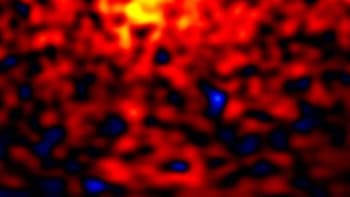
Dark matter had less influence in galaxies 10 billion years ago than it does today, according to observations by the European Southern Observatory’s Very Large Telescope (VLT).
In the modern universe, stars on the outskirts of galaxies rotate just as fast as those in the dense galactic cores. This is surprising because the gravitational glue from the visible matter in a galaxy is not strong enough to stop these outliers from being flung out into space. Such galaxies are said to have “flat rotation curves” and the fact that the rotational velocity does not drop off at large distances from the core has been attributed to extra gravity provided by otherwise invisible dark matter.
Now, astronomers led by Reinhard Genzel of the Max Planck Institute for Extraterrestrial Physics in Germany have shown that galaxies in the early universe didn’t seem to play by the same rules. Instead of flat rotation curves, these young galaxies had rotation curves with a sharp downward dip, caused by stars and gas orbiting the galaxies more slowly on the outskirts than in the centre. The implication is that there was not as much dark matter in the discs of these galaxies as there is in galaxies today. Instead, these early galaxies appear to be dominated by normal, visible “baryonic” matter.
To make the discovery, Genzel’s team measured the rotation velocity of bright star-forming regions in distant galaxies using the KMOS and SINFONI spectrographs on the VLT. Selecting the six best galaxies from a larger data set, they found that all six had the downward dip in their rotation curve. To ensure that these six were not simply flukes, the researchers then stacked and averaged out the rotation curves from 97 other galaxies in their data set and found that downward dips were a common trend.
Unruly beasts
The observations show the galaxies during an era when the formation of stars and galaxies in the universe were at their peak. During this time, “galaxies were unruly beasts”, Genzel told physicsworld.com. They exhibited exceptionally high rates of gas flowing onto them, as well as powerful feedback from supernovae, stellar winds and black holes blowing material back out from these galaxies.
The various accretion and feedback processes afflicting galaxies in the early universe could dump a lot of energy into them, resulting in a wide disparity in rotational velocities around a galaxy. This velocity dispersion would increase with radius, resulting in the outermost parts of a galaxy’s disc rotating more slowly.
Also, during the earliest times in the universe, gas and dark matter were mixed together, but gas was able to separate from dark matter by losing energy more quickly through interactions with other baryonic matter. If the decoupled gas formed a galactic disc fast enough, “then the central regions of galaxies could become dominated by baryons”, says Mark Swinbank of the University of Durham, who was not involved in the research. The high accretion rates of gas flowing onto the galaxies would then reinforce the surfeit of baryonic matter.
The dark-matter story
However, the decoupling of matter as well as the velocity dispersions may not be enough to explain the data, says Genzel. Instead, astrophysicists may also need to look at how dark matter was behaving.
Although physicists have very little understanding of what dark is, several theories have been developed to try to describe the mysterious substance. According to the theory of cold dark matter, galaxies are nestled within giant haloes of dark matter. These haloes aid the growth of galaxies by feeding them gas from the “cosmic web” of matter that spans the cosmos.
“The cold dark-matter paradigm does an extremely good job in mapping out what we have learned over cosmic time about large scale structure and the distribution of galaxies, but maybe the story on smaller scales is wrong,” says Genzel.
Since galaxies were still forming during this early epoch, it is possible that their dark-matter haloes were still in flux and had not yet settled into an equilibrium state where the dark-matter’s gravity could affect the rotation curves. It is also possible that feedback processes could drag dark matter around, rearranging its distribution in the halo relative to the discs of the galaxies. If true, the interaction could provide constraints on dark matter’s properties.
Modelling the data
Astrophysicists will now pour over these data to see if it can be explained using current models of galaxy formation, or whether new ideas will be needed. Current models are in reasonable agreement with the observations, says Simon White, director of the Max Planck Institute for Astrophysics in Germany, “but they would require fine-tuning in terms of star-formation and feedback processes to get precise agreement”.
A more difficult task may be describing how these baryon-dominated galaxies developed into the dark-matter-dominated galaxies that we see in the modern universe. “It’s up to the models to understand how and when dark matter begins to dominate the central regions,” says Swinbank.
The observations themselves may be the key to solving that problem. By determining the distribution of mass in galaxies during different epochs, it will become possible to join the dots. “Putting it all together will allow us to see how things developed from the early universe all the way to the present day,” says White.
Nevertheless, the new findings have raised questions about the relationship between dark matter and galaxy growth. “There will, I’m sure, be a very active and probably controversial discussion,” admits Genzel. “It’s going to be an interesting time.”
The research is described in four papers, one published in Nature and three supporting papers published in The Astrophysical Journal.



